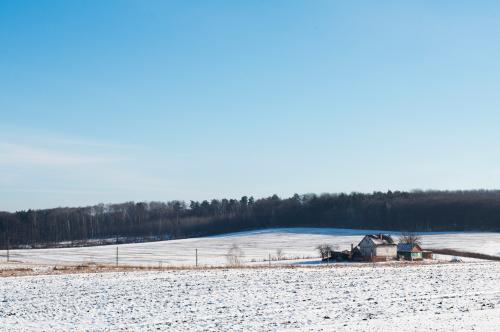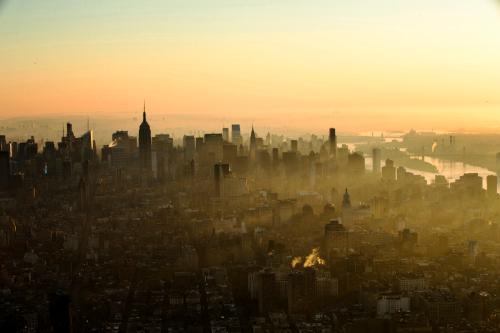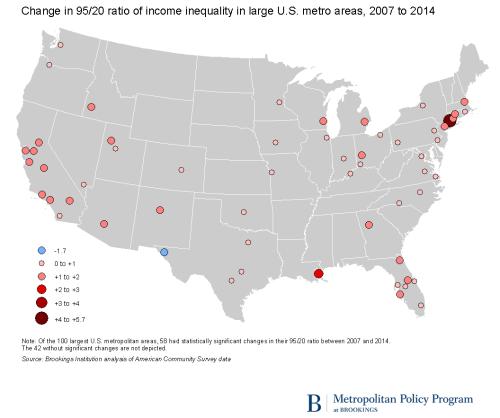President Trump’s executive order banning travel to the United States for 90 days from seven predominantly Muslim countries—Iran, Iraq, Libya, Somalia, Sudan, Syria, and Yemen—and suspending refugee resettlement for 120 days has rightly provoked widespread controversy and criticism. As my Brookings colleague Benjamin Wittes forcefully argues on the Lawfare blog, the order not only runs counter to the national security interests it purports to advance, but also inflicts great harm on vulnerable, concededly innocent people. Already, federal courts have issued rulings that would prevent the deportation of certain immigrants and refugees affected by the order; signals are currently changing from hour to hour as to whether the Trump administration will abide by those rulings.
Many big-city mayors in the United States are speaking out against the executive order. Mayors in Boston, Los Angeles, New York, Philadelphia, San Francisco, and Seattle, among others, have issued statements and joined protests to denounce the order and to support immigrants and refugees. They recognize that many individuals affected by the order are essential parts of the diverse cities they govern. Their protests of the order coincide with a wider set of strategies that Democratic mayors seem poised to undertake to oppose the Trump administration on issues such as criminal justice and civil rights, climate change, and support for the safety net.
While it’s true that these big cities are home to large numbers of affected individuals and communities, they aren’t the only places with a significant stake in the matter. Data from the U.S. Census Bureau show that many places around the country—both large and small—are home to immigrant populations from the countries targeted by Trump’s executive order. Under the order, members of those immigrant communities may find it impossible—at least in the short term—to bring family to the United States, and to travel to their countries of origin and subsequently gain readmission to the United States.
At the metropolitan scale, the places with the largest numbers of foreign-born individuals from six of the named countries (Libyan-born individuals are not identified separately in the Census Bureau data) include many of the largest places overall. Los Angeles leads all others with 161,000, chiefly due to the large number of Iranians who settled there in the early 1980s in the wake of the revolution; the University of Southern California is one of the top destinations for U.S. students from Tehran. New York, Chicago, Dallas, Houston, and Washington all rank among the top 10 metro areas for both total population and population from the six countries. Greater Detroit actually has the second largest number of residents from those countries, about 15,000 more than the New York metro area, which is nearly five times its size. The Detroit metro area has almost twice as many Iraq-born individuals as the second-largest metro destination (San Diego), as well as significant communities of Yemenis and Syrians. Many of those individuals have settled in the Detroit suburb of Hamtramck, which is now home to the nation’s first majority-Muslim city council. Together, the 20 metro areas with the largest number of residents from the six countries contain nearly three-quarters of all such residents across the nation’s 381 metro areas.
Metropolitan areas with the largest number of residents born in “banned countries,” 2011-2015
| Metro area | Iran | Iraq | Somalia | Sudan | Syria | Yemen | Total |
|---|---|---|---|---|---|---|---|
| Los Angeles, CA | 136,000 | 8,500 | 500 | 600 | 14,900 | 100 | 160,800 |
| Detroit, MI | 1,600 | 46,800 | 0 | 200 | 4,300 | 11,300 | 64,300 |
| New York, NY-NJ-PA | 21,700 | 3,300 | 300 | 1,900 | 10,900 | 11,100 | 49,100 |
| San Diego, CA | 10,700 | 24,400 | 2,400 | 300 | 1,100 | 100 | 38,900 |
| Washington, DC-VA-MD-WV | 21,500 | 5,600 | 2,900 | 3,500 | 2,000 | 500 | 36,000 |
| Chicago, IL | 6,700 | 13,100 | 900 | 700 | 5,700 | 1,400 | 28,400 |
| Minneapolis-St. Paul, MN-WI | 1,400 | 800 | 19,900 | 1,100 | 100 | 100 | 23,500 |
| San Francisco-Oakland, CA | 16,300 | 1,400 | 0 | 300 | 900 | 3,000 | 22,000 |
| Houston, TX | 10,300 | 4,700 | 900 | 900 | 1,700 | 100 | 18,500 |
| Dallas-Fort Worth, TX | 8,700 | 4,800 | 1,400 | 1,900 | 1,100 | 100 | 18,000 |
| Seattle, WA | 5,900 | 2,600 | 7,500 | 800 | 600 | 400 | 17,900 |
| Phoenix, AZ | 5,100 | 8,600 | 1,300 | 1,400 | 900 | 100 | 17,300 |
| San Jose, CA | 14,200 | 1,500 | 300 | 200 | 400 | 0 | 16,600 |
| Atlanta, GA | 5,300 | 1,900 | 2,600 | 1,300 | 900 | 100 | 12,200 |
| Columbus, OH | 1,100 | 1,400 | 8,900 | 200 | 500 | 0 | 12,200 |
| Boston, MA-NH | 4,200 | 1,500 | 2,200 | 600 | 1,900 | 0 | 10,400 |
| Riverside-San Bernardino, CA | 5,100 | 1,500 | 100 | 0 | 2,600 | 100 | 9,400 |
| Nashville, TN | 1,700 | 3,900 | 1,600 | 1,200 | 200 | 200 | 8,800 |
| Sacramento, CA | 6,100 | 1,400 | 200 | 100 | 500 | 100 | 8,400 |
| Modesto, CA | 4,300 | 3,100 | 0 | 0 | 100 | 300 | 7,800 |
| Total for 20 metro areas | 288,000 | 140,800 | 53,900 | 17,200 | 51,300 | 29,100 | 580,500 |
| All other metro areas | 76,900 | 49,400 | 25,500 | 22,000 | 23,800 | 10,300 | 208,000 |
Note: Data for Libya, one of the seven nations affected by the order, were not available.
Source: Brookings analysis of 2011-2015 5-year American Community Survey data. Observations rounded to nearest 100.
Detroit also leads all other metropolitan areas in the share of its total population from the six countries. From 2011 to 2015, it had 15 residents from Iran, Iraq, Somalia, Sudan, Syria, and Yemen per 1,000 total residents. Los Angeles and San Diego fell not far behind, with 12 residents from those countries per 1,000 total residents. But many smaller communities that have welcomed refugees from these countries for many years figure among those with the largest shares of these residents, such as Modesto, Calif., Rochester and St. Cloud, Minn.; Fargo, N.D.; Harrisonburg, Va.; Lincoln, Neb.; Iowa City, Iowa; Portland, Maine; and Ann Arbor, Mich. A few of these places are home to significant educational and medical institutions (e.g., the Mayo Clinic in Rochester, James Madison University in Harrisonburg, the University of Iowa in Iowa City, and the University of Michigan in Ann Arbor) that have attracted highly-qualified faculty and students from those countries. Greater Minneapolis-St. Paul is meanwhile home to the nation’s largest community of Somali-born individuals, and the top metropolitan destination for refugee resettlement from that war-torn nation.
Metropolitan areas with the highest shares of residents from “banned countries,” 2011-2015
| Metro area | Total population | Total from banned countries | Number from banned countries per 1,000 population |
|---|---|---|---|
| Detroit, MI | 4,296,400 | 64,300 | 15.0 |
| Modesto, CA | 527,400 | 7,800 | 14.9 |
| Los Angeles, CA | 13,154,500 | 160,800 | 12.2 |
| San Diego, CA | 3,223,100 | 38,900 | 12.1 |
| Rochester, MN | 211,300 | 2,400 | 11.4 |
| St. Cloud, MN | 191,800 | 1,800 | 9.6 |
| San Jose, CA | 1,925,700 | 16,600 | 8.6 |
| Fargo, ND-MN | 223,400 | 1,800 | 8.2 |
| Harrisonburg, VA | 129,200 | 900 | 7.2 |
| Lincoln, NE | 315,100 | 2,100 | 6.8 |
| Minneapolis-St. Paul, MN-WI | 3,458,800 | 23,500 | 6.8 |
| Columbus, OH | 1,972,400 | 12,200 | 6.2 |
| Washington, DC-VA-MD-WV | 5,949,400 | 36,000 | 6.0 |
| Iowa City, IA | 161,500 | 900 | 5.6 |
| Portland, ME | 520,900 | 2,900 | 5.6 |
| Grand Island, NE | 84,000 | 400 | 5.3 |
| Nashville, TN | 1,761,800 | 8,800 | 5.0 |
| Seattle, WA | 3,614,400 | 17,900 | 5.0 |
| San Francisco-Oakland, CA | 4,528,900 | 22,000 | 4.8 |
| Ann Arbor, MI | 354,100 | 1,700 | 4.8 |
Note: Data for Libya, one of the seven nations affected by the order, were not available.
Source: Brookings analysis of 2011-2015 5-year American Community Survey data. Observations rounded to nearest 100.
For now, the executive order remains focused on seven Muslim-majority countries, but White House Chief of Staff Reince Priebus indicated on Sunday that the ban could be expanded: “Perhaps other countries needed to be added to an executive order going forward….” Adding new countries to the list could put into the cross hairs additional communities with large shares of residents from nations such as Pakistan (Stockton and Yuba City, Calif.), Indonesia (Corvallis, Ore.), or Saudi Arabia (Pocatello, Idaho and Bowling Green, Ky.).
In that light, the spread of protests this weekend beyond the nation’s big coastal cities, to significant centers like Detroit and Minneapolis, but also Boise, Dallas, Omaha, and Phoenix, reflects a broad awareness that immigrants and refugees—from wherever they originate—add immensely to the social, economic, and cultural fabric of our country as a whole, and individual communities of all sizes and political persuasions. Their residents are right to denounce this cruel and misguided action from the Trump White House.
The Brookings Institution is committed to quality, independence, and impact.
We are supported by a diverse array of funders. In line with our values and policies, each Brookings publication represents the sole views of its author(s).







Commentary
These communities have a lot at stake in Trump’s executive order on immigration
January 30, 2017